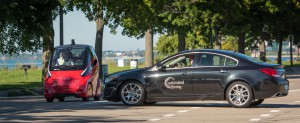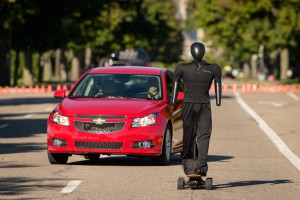
The Opel Insignia demonstrates intersection collision avoidance with a Chevrolet EN-V 2.0 second generation electric networked vehicle.
In July, the streets of Belle Isle, Detroit’s history island park in the Detroit River, saw Indy cars roaring around the road venue, but now it is hosting self-driving two-seaters that are closer to floating bubbles than open-wheel racers.
The night after Mary Barra, General Motors CEO, announced the Cadillac brand will be the first of the maker’s products to get Super Cruise, a slew of technologies that make a vehicle nearly autonomous, the maker showed off the next step in that technology, led by the second generation EN-V, Chevrolet’s electric networked vehicle.
GM showed off its original two-wheeled EN-V concept in 2010 at Shanghai World Expo, but the latest version is a four-wheeler with all-wheel drive that uses a slew of cameras, laser radar (lidar) and V2X communications “offer a hands-free, low-speed electric driving experience.”
Built for low speeds, the EN-V can drive 25 miles on a charge and looks more like a bubble on wheels than a small car. While small, technologically speaking, it’s mighty. It uses the aforementioned technology to offer collision avoidance, adaptive cruise control and other mitigation technologies. It also can be driven remotely using a smart phone to allow for automated valet parking and vehicle retrieval.
GM demonstrated a non-autonomous version of the EN-V 2.0 vehicle for two weeks in June in the Tianjin Eco-City.

The Chevrolet Cruze demonstrates vehicle-to-pedestrian crash avoidance technology that can detect pedestrians in the path of the vehicle.
“We continue to develop intelligent and connected driving technologies because they are critical elements in the evolution towards safer driving,” said Jon Lauckner, GM’s chief technology officer, vice president of Global Research and Development, and president of GM Ventures. “With every incremental step we take, we move closer to a vehicle, that one day, will avoid crashes.”
(Cadillac to offer nearly autonomous car by 2017. For more, Click Here.)
Crash avoidance was one of the top capabilities on display at the maker’s demonstration area in Detroit. Using mannequins on skateboards mounted atop RC cars, the displayed its crash avoidance technology by using cameras to avoid “people” on the roadway as well as vehicle-to-vehicle, also known as V2V, communication to avert crashes.
(Click Here for details on Mercedes production plans for Alabama plant.)
A gas-powered Opel Insignia outfitted with cameras, Lidar sensors, V2V and vehicle-to-infrastructure (V2I) communication technologies, demonstrated a future vehicle that can handle both low-speed, stop-and-go city driving and highway-speed automated driving.
(To see more about a new link up between Tesla and Toyota, Click Here.)
The six Lidar sensors in the bumpers of the Insignia constantly use light scanning to identify objects around the car. The forward pointing camera on top of the car reads lane markings and detects other objects.
The V2V and V2I technologies located in an antenna on top of the car work to communicate with other objects that the vehicle encounters. The car also uses GPS satellite to constantly remain aware of its position on the roadways. All of these inputs are fused through GM’s sensor fusion technology to enable 360 degrees of awareness and object detection.
